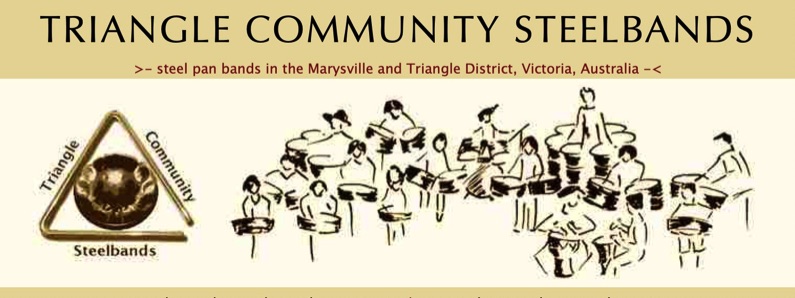The History of Triangle Community Steelbands
The 2009 Black Saturday Bushfires
Saturday 7th February 2009 was a significant day in the history of the towns of Marysville, Narbethong, Buxton and Taggerty - the towns that make up the Triangle District in the Shire of Murrindindi. On that day, Black Saturday, when the temperatures were approaching 50 degrees centigrade, bushfires raced in from the west and the north and then having reached Narbethong the fire turned northwards with a southerly wind change. Having caused extensive damage in the northern part of Narbethong, the fire decimated Marysville, miraculously skirted around much of Buxton, and was then stopped 50m short of the town of Taggerty by valiant CFA firefighters (and a little good luck). The fire continued to burn in the region for the next two weeks, but the main damage had already been done.
In total, the Black Saturday fires in the Kinglake-Marysville complex claimed 159 lives (34 in Marysville alone) and over 1800 properties (only 14 of 400 buildings survived in Marysville). In the months after the fires, a variety of community meetings were held to think about what could be done to begin the recovery process. As well as thinking about the physical damage that needed to be overcome, there was also the issue of social and emotional damage.
The Start of the Idea
In the winter of 2009, Rita Seethaler had to go to Switzerland to visit her sick mother. While she was there, she talked with friends in Bern, with whom she had played steel pans for many years before coming to Australia. She told them about the fires, and the social upheaval they had caused. At the same time, she learned of some Regional Arts Victoria grants that were available for social recovery programs involving the arts in the bushfire areas. As often happens, two disparate ideas came together at one point in time, and so the idea of starting a steel band in the Marysville and Triangle District emerged, as a way of helping with the recovery process. In discussing this with her Swiss friends, some immediately offered donations of steel pans they were no longer using. So, Rita had some excess baggage with her on the flight home to Australia, along with the germ of an idea.
You can hear Rita explain all this in her own words in this extract from the Regional Arts Victoria video, "At the Coalface":
Getting the Pans Made
One of the people that Rita spoke to in Bern was a friend she had know since he was a young boy in a junior steel band, Werner Egger. Through trips to Trinidad and working in the field, Werner had become an expert pan-maker and tuner. When he heard about Rita's idea, he volunteered to come to Australia to help her make a set of instruments for the project.
Many people are surprised to learn that steel pan instruments are made of of 44-gallon oil drums. However, not everyone can make such an instrument (and get it to sound good). Werner is one of those people. There are a large number of steps involved in how the Pans on Fire steel pans were made, as described below (and described in much more detail here).
Selecting the Drum
Theoretically, any 44-gallon drum can be made into a steel pan. However, in practice it has to be in good condition, with little rust, empty of its previous contents, and no stamp marks or holes in the surface to be turned into a steel pan. The thickness of the steel can also make a difference, with thicker steel generally regarded as being better to work with.
For the making of the Pans on Fire steel pans, we searched without success for used steel pans, and then eventually decided to get new drums. We were very fortunate to find some very generous people at VIP Packaging who, among other things, make steel drums for industry. When we explained our plight and the fact that it was for a bushfire recovery project, they were more than happy to help us. Their workers also become very interested in the project, and made many useful suggestions. In the end, they made a special batch of drums for us, with closed ends on both ends of the drum (which enabled us to make two steel pans out of the one drum (which is normally not possible). To top it all off, they charged us nothing for the drums - all we had to do was provide the transport to get the drums to Taggerty.
Thank you VIP Packaging!

Marking Out
Once we had picked up Werner Egger (our volunteer pan-maker from Switzerland) and got him up to Taggerty, he started with the pan-making process. The first step was to mark out the drum, ready for sinking.

Sinking
Werner then proceeded on the hard work of sinking the pan, using special wooden hammers. Werner was thrilled to be presented with a unique Red Gum hammer made by Taggerty woodworker Clarrie Glass.
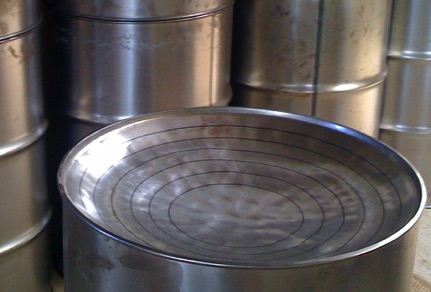
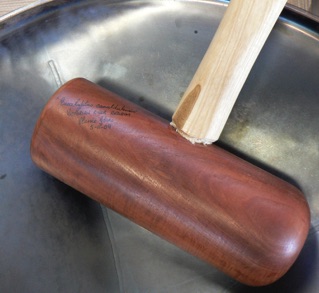
Forming
Once the pan had been fully sunk, it was then marked out for the specific pan being created and then formed and shaped to produce the areas for the notes.

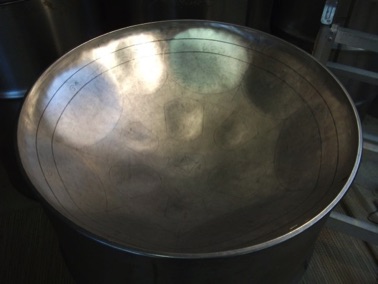
Grooving
To isolate one note from the next on the pan, to prevent vibrations being set up in neighbouring notes when one is struck, the edges of the notes are "grooved" or "scribed" using a nail punch or a scribing tool.
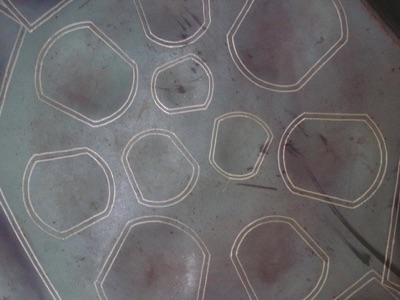
Cutting
Once the grooving and re-shaping process has been completed, the pan in separated from the rest of the drum by cutting the sides (the "mantle") to an appropriate length (higher pitch pans need shorter mantles).
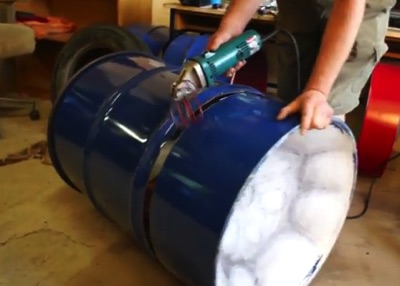
Tempering
All the stresses induced in the surface of the pan during the sinking, grooving and shaping processes need to be relieved before the final tuning can take place. This stress relief ("tempering") is done by heating the pan, and then cooling it. This was formerly done over an open fire, but these days is often done with a gas blow-torch.
Tuning the Pans
The final stage in the making of the pan is the tuning process, where each note is tuned to it's major note, its fundamental pitch, and then its "partials". If the partials are not in a harmonic relationship to the fundamental then, when struck, the sound will be harsh and metallic. Tuning is an art form to get as many harmonic partials as possible in the one note on the pan. Some turners insist they can tune by ear (at least until they start to lose their hearing by playing too many years in a steel band), whereas most tuners acceptance some electronic assistance by the use of a StrobeTuner (as least to get the fundamental note correct). Getting the harmonics mostly relies on the ear.
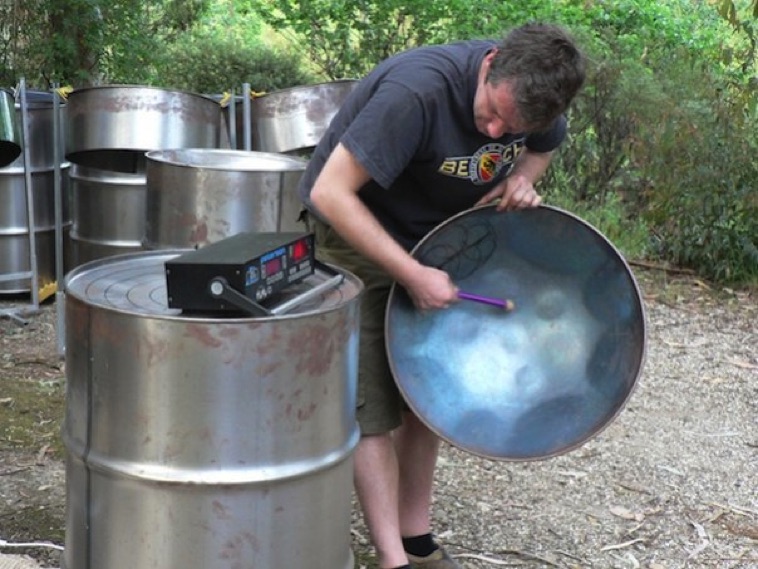
Once the pan has been tuned, there may be some further steps in the fine tuning, the pan may be chromed (for appearance and protection, after which it must be re-tuned), and then after the pans are into use there is the ongoing task of re-tuning them after they drift out of tune with use, or after they are dropped, or after they are left in direct sunlight (which effectively heats them, releases the stresses built in during tuning and effectively re-tempers them again).
For a good audio-visual description of how Werner made the Pans on Fire pans, check out this extract from Barry Thomas' Great Stories video about Pans on Fire.
Finding the Players
Now that we had some pans, we had to find some players! So an "Open Day" was arranged at the "Taggerty Panyard" on Sunday, 14th November 2009, just two weeks after Werner had arrived in Australia. On the day, Werner explained how the pans had been made, and then Rita, Werner and Lennox Jordan (a Trinidadian friend of Werner's who was living on the Sunshine Coast) gave a small concert to show what the pans sounded like. Also in the band that day was Brad Harkin, a backpacker who was staying in the area and who volunteered to make the pan stands, who was given rapid instruction in how to play the six bass. One of the highlights of the day was listening to Lennox playing "Autumn Leaves" solo; it was only then that people realised how beautiful a steel pan could sound.
...
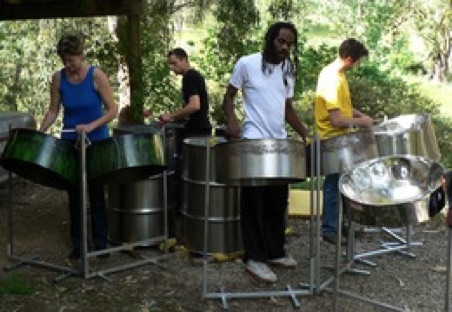
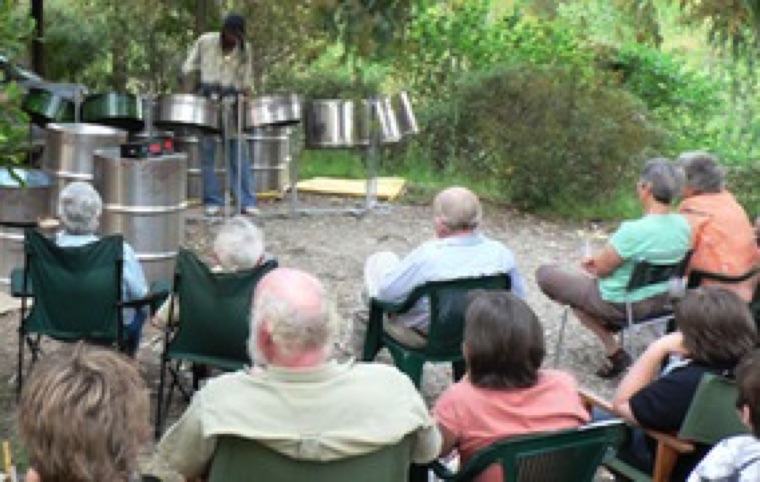
Forming Pans on Fire
Pans on Fire (as it was later named) was the first of the steel bands to emerge from that first Open Day at the Taggerty Panyard. It began to form organically over the Christmas 2009 period as word spread among friends about this strange new sound being created in Taggerty. By January 2010, we had the core of the band assembled. Since very few people had any real musical experience (and most had never even seen a steel pan), it all began slowly with rhythm exercises outdoors and then some indoor exercises with the pans. Everyone was excited, but slightly bemused. In the early days, there was a bit of turnover in the band as various people gave it a try; some stayed, some moved on.
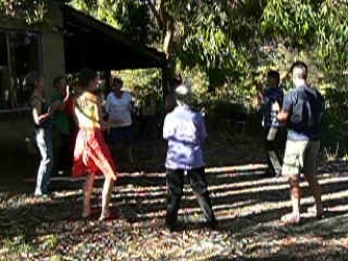
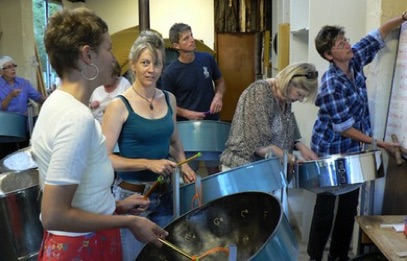
By mid-January, the majority of the current Pans on Fire group had started to join in on practice. In those balmy summer days, we often practiced outdoors (to escape the heat of the Shed), with everyone offering support to each other.
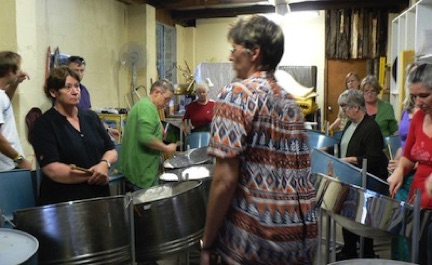
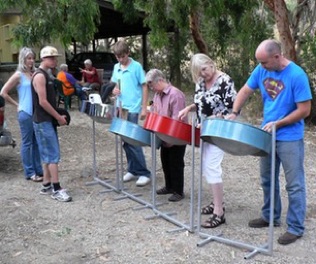
The first song we really learnt was African Marketplace. We celebrated this at the end of January when we held an African Marketplace Drumming Workshop with "DrummerGirl" Simone Lang. Finally, we were starting to learn about rhythm!
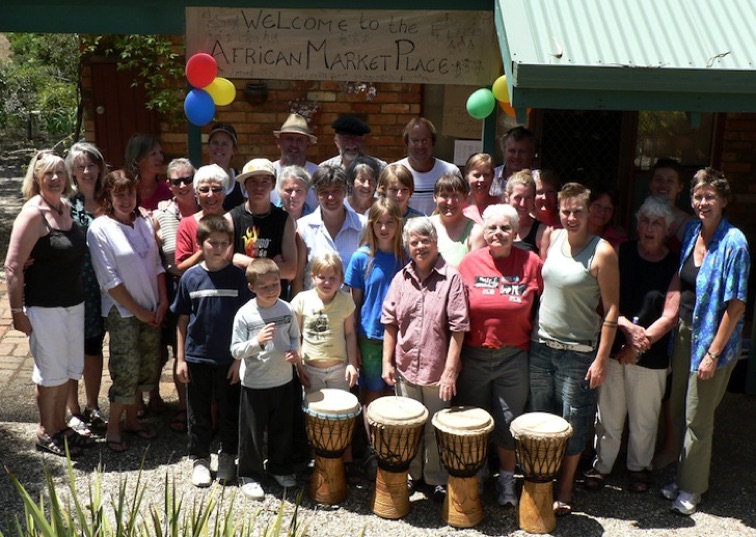
The next couple of months saw lots of practice; sometimes it was gregarious, and sometimes it was solitary.
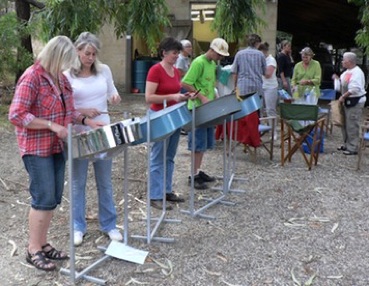
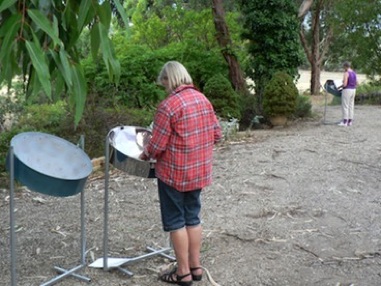
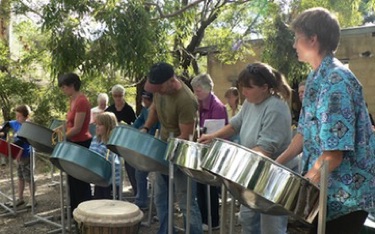
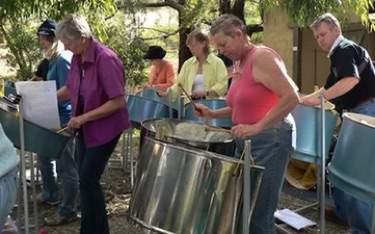
The next big event was a repeat Drumming Workshop with the DrummerGirl, but this time it was combined with a Pan Workshop run by Lennox Jordan. That weekend was a great learning experience. In two days, we learned two new songs (Sugar Bum and Recovery, a song composed and arranged that weekend by Lennox especially for Pans on Fire).
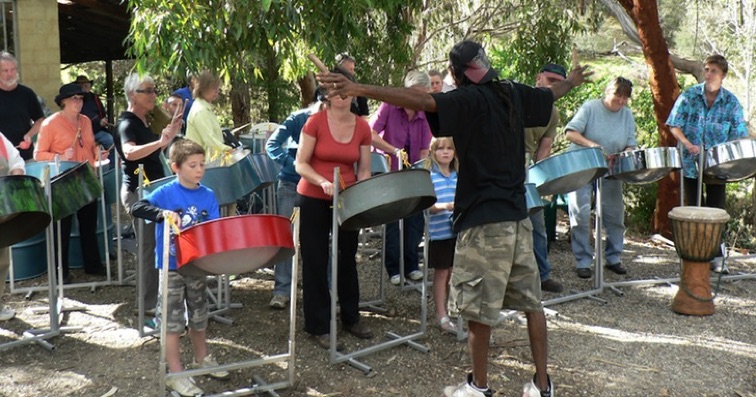
The following week, we had our first "gig" at the Marysville Sustainability Expo. We played our full repertoire of four songs several times over during the day, and everyone (especially the band members) seemed to enjoy it!
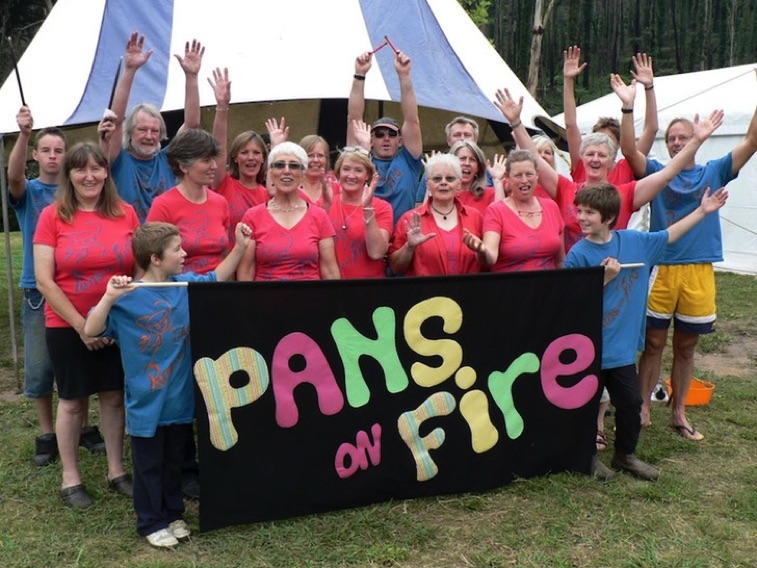
And the rest, so they say, is history!
For more about what Pans on Fire has done since then, check out the Gig Guide.
The Pan Bus
Once we started playing a few gigs, we realised that one of the problems was getting the pans to and from the venues (especially the two sets of six bass). We therefore started to think about getting a band vehicle. From her days when playing in steel bands in Switzerland, Rita had always been keen on getting a "band bus". So that is what we started looking for. Eventually we found a local bus operator in nearby Alexandra (Fallons) who were looking to trade-in an old school bus. So after checking that the pans would fit and that the interior could be converted to hold them, we bought the bus from them. The bus was a 1988 Hino AC140, with nearly 700,000km on the clock, but we were assured it would keep running "for ages". When we bought the bus, all the passenger seats were stripped out (so that it was no longer classified as a passenger bus). It was also a very tight fit under the roof of the carport next to the Panyard Shed, so we literally had to "raise the roof".

Another Swiss friend "on holiday" in Australia, Gere, did the work on the carport and also did the fit out on the bus interior. Now we have a band bus that can easily carry all the instruments for Pans on Fire, especially for the longer "road trips". We were very fortunate to be able to get special custom licence plates for the vehicle!
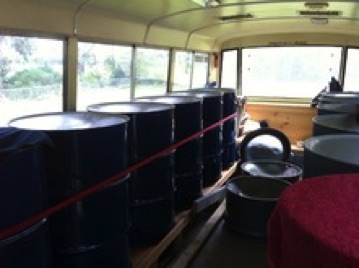
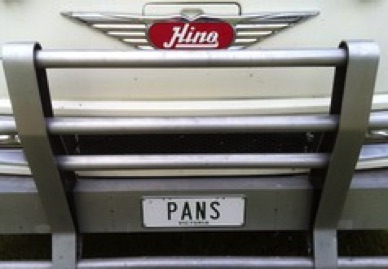
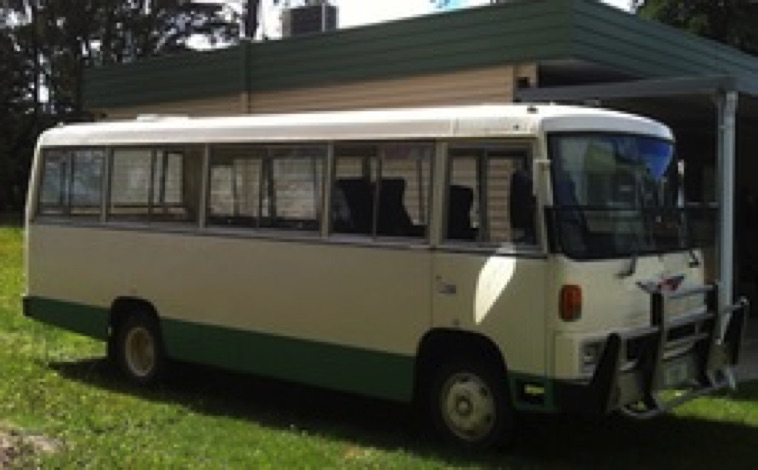
Forming Hot Pans
In early-2011, there was a waiting list of people wanting to join the band. So we started another band (later to be named Hot Pans) and got on with starting the learning process all over again. Once again, most of the members were non-musicians who came from the fire-affected Triangle district. After eight months of practice, their first gig was solo and as part of the "big band" at the Calypso Night in October 2011 (shown below in the purple shirts).
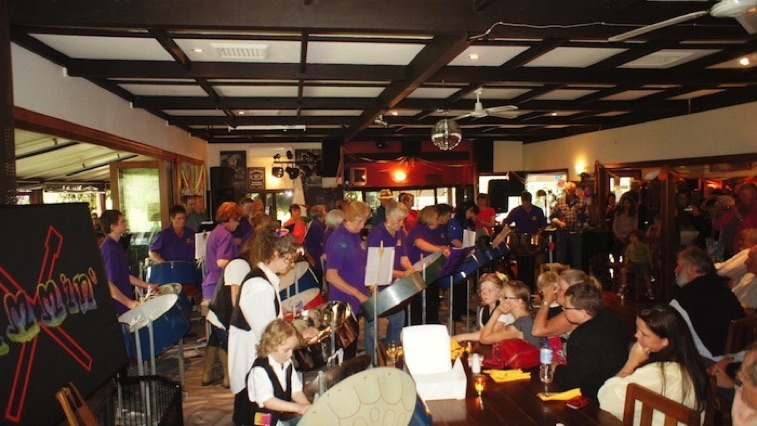
Forming Jammin'
A "mums and kids" band was part of the set-up from the earliest days, but this took more shape in 2011 with the creation of Jammin' under the guidance of Werner Egger. Their first gig was at the Cartwheels Festival in Alexandra in October 2011.
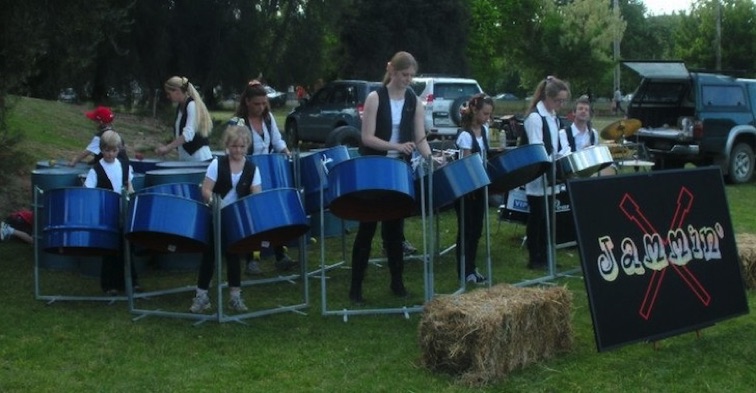
Special Thanks
There are three people who deserve special thanks for the creation of Triangle Community Steelbands. First and foremost, Rita Seethaler for her crazy idea in the first place and for her commitment and perseverance ever since. Second, Werner Egger for building most of the pans and for guiding the development of Jammin'. Thirdly, Lennox Jordan for being so quick to lend Werner a hand, and for teaching us so much about playing the pans and for his compositions and arrangements, and for his later efforts in ongoing tuning of the pans. Without these three, Triangle Community Steelbands would not exist.
